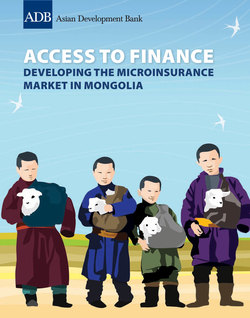Access to Finance

Реклама. ООО «ЛитРес», ИНН: 7719571260.
Оглавление
Kelly Rendek. Access to Finance
ACCESS TO FINANCE. DEVELOPING THE MICROINSURANCE MARKET IN MONGOLIA. Access to Insurance Initiative
Contents
Tables and Figures
Foreword
Acknowledgments
About the Access to Insurance Initiative
Abbreviations
Executive Summary
Strategies and Recommendations
Introduction
Definition of Microinsurance
Methodology
Structure of Analysis
Context
Macroeconomic Trends
Socioeconomic Trends
Employment and labor force
Education
Household Income and Measures of Poverty
Financial Services
Banks and Microfinance
Savings and Credit Cooperatives
Capital Markets
Technology
Social Welfare
Social Health Insurance
Pensions
Social Welfare Benefits
Insurance
Insurance Providers
Informal Market
Insurance Products
Nonlife, Short-Term Products
Long-Term Insurance, Including Life Insurance
Client Value
Distribution and Premium Collection
Professional Technical Capacity and Training
Information Technology Systems Constraints
Existing Microinsurance Landscape. Overview of Microinsurance Schemes
Microinsurance Development Projects. United Nations Development Programme Microinsurance Capacity Building Project
Tenger Insurance and Xac Bank Microinsurance Project
Index-Based Livestock Insurance Program
Other Microinsurance-Type Products
Emerging Lessons from Microinsurance Projects in Mongolia
Estimating the Potential Demand for Microinsurance
Microinsurance Client Profile
Focus Group Research Conducted for Access to Insurance Initiative Diagnostic
Demographic Profile of Participants
Income, Expenditures, and Savings
Understanding of Risk
Risk Management
Community approaches to risk management
Understanding of Insurance
Additional Demand-Side Research
Cultural Aspects
Potential Demand for Microinsurance in Mongolia. Current Microinsurance Usage
Microinsurance Client Profile
Estimating Potential Demand
Regulation, Supervision, and Policy
Political System and Legal Environment
Financial Sector Authorities
Insurance Development Policies
Access to Financial Services
Insurance Laws and Regulations. General Legislation
Insurance Sector Legislation
Insurance Regulations and Guidance
Non-Insurance Legislation with Relevance to Insurance and/or Microinsurance
Microinsurance Implications
Regulation of Insurance Intermediation
Definition and Classification of Insurance
Regulations Relating to Consumer Protection
Consumer Protection Regulation
Market Conduct Regulation
Beneficiaries and Insurable Interest
Privacy Regulation
Further Regulatory Issues with Potential Impact on Microinsurance Development. Terminology and Translation Issues
Regulation of Foreign Insurers and Reinsurance
Telecommunications Regulation
Supervision and Capacity. Supervisory Approach
Regulatory Process
Capacity Challenges
Systems Capacity
Key Drivers for the Microinsurance Market in Mongolia
Donor Engagement
Policy and Regulatory Considerations
Inhibiting Factors
Enabling Conditions
Recommendations
Recommendation 1: Strengthen access to insurance through the formulation of a coordinated financial inclusion policy
Recommendation 2: Develop a strategic approach to promote access to insurance, and outline a regulatory course of action for the FRC
Recommendation 3: Industry participants should develop sustainable microinsurance programs based on market research and good business case
Recommendation 4: Ease regulations on insurance intermediaries
Recommendation 5: Expand regulations to create options for insurance providers and intermediaries to foster innovation in product development, distribution, and sustainable business models
Recommendation 6: Define microinsurance products that would be allowable under both life and nonlife classifications. Clarify and maintain consistency in the definitions and insurance classification in laws and regulations
Recommendation 7: Improve regulations and supervisory practices on consumer protection
Recommendation 8: Develop a capacity building strategy for the FRC
Recommendation 9: Standardize insurance terminology and translations used in the industry
Recommendation 10: Assist the Mongolian Society of Actuaries to develop the actuarial profession in Mongolia in collaboration with the International Actuarial Association (IAA)
Recommendation 11: Assist the Mongolian Insurers Association to develop an independent Insurance Training Institute
Recommendation 12: Implement an online database management system within the FRC’s Insurance Department
Recommendation 13: Development organizations need to ensure their programs support capacity development without skewing the development of the overall insurance market
Moving Forward
APPENDIX 1. Financial Regulatory Commission Resolution No. 16 (2009)—Allowable Insurance Categories
APPENDIX 2. Law on Insurance (2004), Article 8, Insurance Payments
APPENDIX 3. The Responsible Finance Framework1. 1. What is responsible finance?
2. Whose responsibility is it?
3. What strategies and measures promote responsible finance?
APPENDIX 4. The Insurance Core Principles of the International Association of Insurance Supervisors (2011)1. ICP 1—Objectives, Powers and Responsibilities of the Supervisor
ICP 2—Supervisor
ICP 3—Information Exchange and Confidentiality Requirements
ICP 4—Licensing
ICP 5—Suitability of Persons
ICP 6—Changes in Control and Portfolio Transfers
ICP 7—Corporate Governance
ICP 8—Risk Management and Internal Controls
ICP 9—Supervisory Review and Reporting
ICP 10—Preventive and Corrective Measures
ICP 11—Enforcement
ICP 12—Winding-up and Exit from the Market
ICP 13— Reinsurance and Other Forms of Risk Transfer
ICP 14—Valuation
ICP 15—Investment
ICP 16—Enterprise Risk Management for Solvency Purposes
ICP 17—Capital Adequacy
ICP 18—Intermediaries
ICP 19—Conduct of Business
ICP 20—Public Disclosure
ICP 21—Countering Fraud in Insurance
ICP 22—Anti-Money Laundering and Combating the Financing of Terrorism (AML/CFT)
ICP 23—Group-Wide Supervision
ICP 24—Macroprudential Surveillance and Insurance Supervision
ICP 25—Supervisory Cooperation and Coordination
ICP 26—Cross-border Cooperation and Coordination on Crisis Management
APPENDIX 5. Focus Group Research: Income, Expenditures, and Savings
APPENDIX 6. United Nations Development Programme Microinsurance Project Demand Study
Information on Households Surveyed
Knowledge of Insurance
Product Development
Insurance Delivery Partners
APPENDIX 7. The Law Making Process in Mongolia
APPENDIX 8. Comparative Results from Microinsurance Focus Group Discussions in Swaziland1
APPENDIX 9. Examples of International Responses to Microinsurance Policy, Regulation, and Supervision
Bibliography
Отрывок из книги
Kelly Rendek and Martina Wiedmaier-Pfister
To mitigate these risks, there needs to be a sound portfolio of affordable insurance products and services made easily available to the public. Access to microinsurance can help vulnerable households maintain a sense of financial confidence in the face of illnesses, injuries, or even death of family members, loss of property or natural catastrophes. The effect of these risks on their limited financial resources could prove to be fatal.
.....
The microinsurance market in Mongolia is in its early stages, and microinsurance pilots have only been initiated in the last few years. Existing products include health insurance offered through the microinsurance project of the United Nations Development Programme, health and accident coverage under Tenger’s microinsurance product, and index-based livestock insurance offered through the Index-Based Livestock Insurance Program. So far, none of these programs have demonstrated sufficient success for long-term sustainability.
Analysis of these pilot projects reveal a number of emerging lessons that can be leveraged for future microinsurance development:
.....